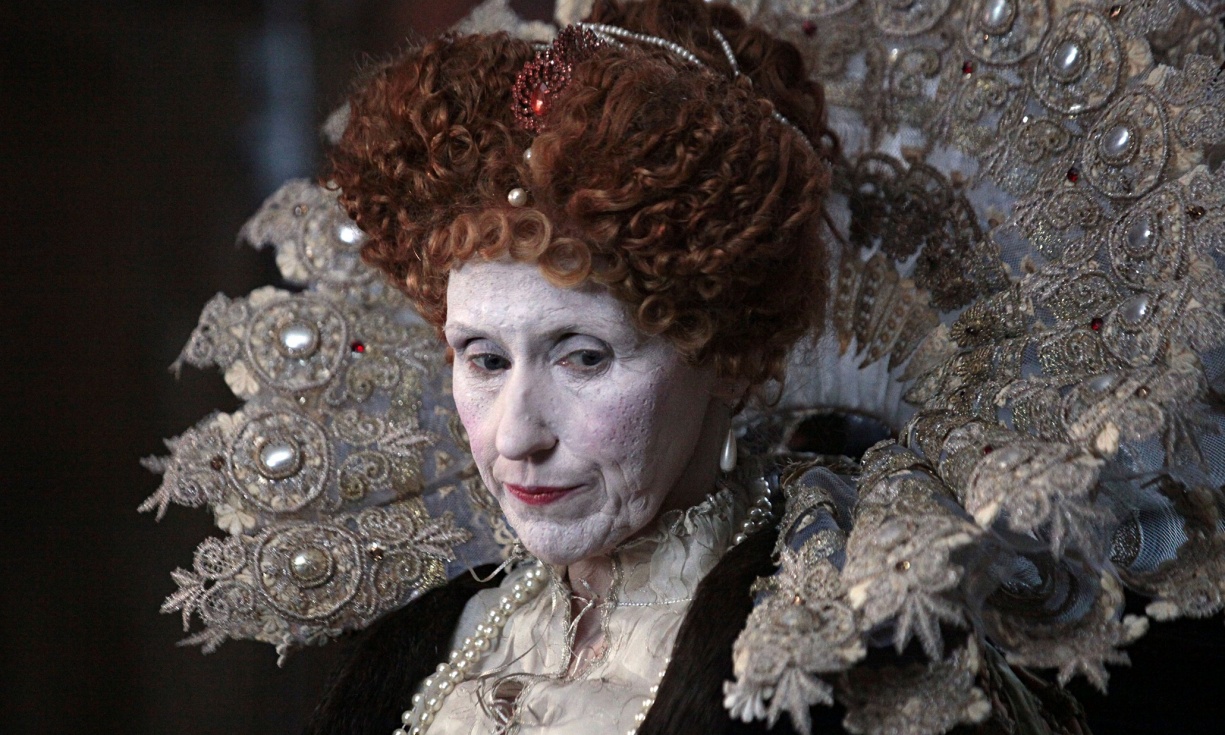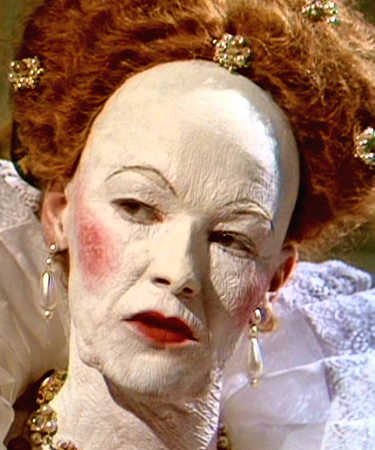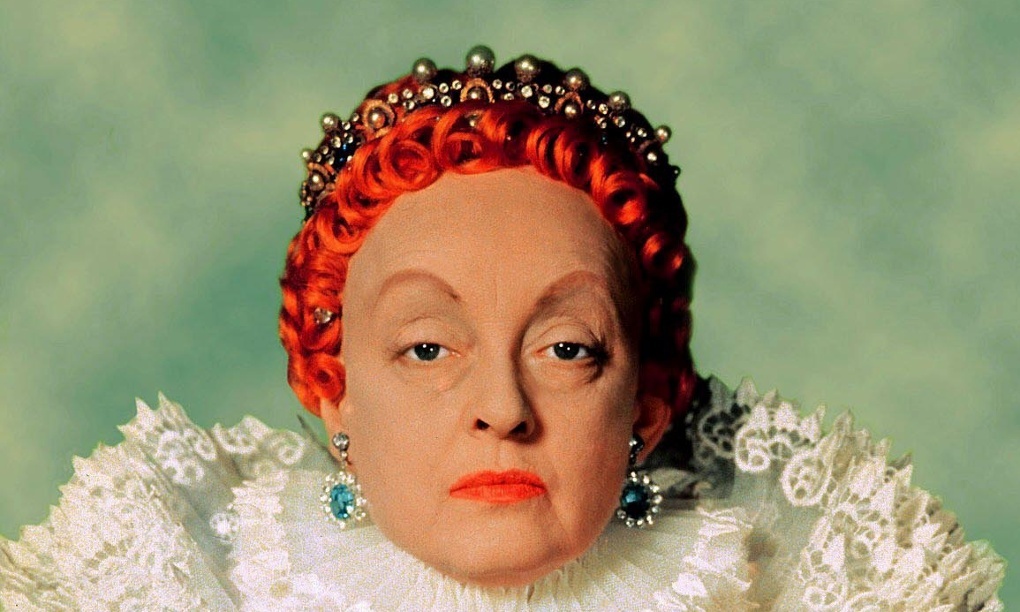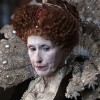Why is Elizabeth I, the most powerful woman in our history, always depicted as a grotesque?
written for The Guardian, 25 May 2015

‘Streaked with white and red makeup, Anita Dobson resembled nothing so much as Heath Ledger’s Joker.’
Zounds! The BBC’s new docu-drama series, Armada, opened last night with visual reenactments of all the hoary tropes of Elizabethan storytelling: a beleaguered isle, led by a vacillating queen; plucky English sailors knocking together a flotilla from the few planks of driftwood and some Vaseline; wordless, faceless Spaniards, bearing down with dark crucifixes upon their captives as instruments of torture.
Presiding over all of this – though she never seemed to do much – was a figure few Elizabethans would have recognised. Streaked with white and red makeup, Anita Dobson resembled nothing so much as Heath Ledger’s Joker, or perhaps his copycat grandmother. This was what we’d been led to expect – Dobson, starring in the reconstructions, had been trailed as the mature foil to youthful presenter Dan Snow, who steered the documentary segments; much of Armada’s pre-publicity consisted of Dobson granting “exclusive” insights into the four hours she’d spent in makeup each day, layering on wrinkles, “leather-spots” and blackened teeth.
Fair enough – if I were a youthful-looking 66-year-old, like Dobson, I’d want to stress that uglification on screen was purely prosthetic. But Armada was obsessed with Elizabeth’s ageing body. From its first (counterfactual) scene of a shivering, balding Elizabeth thrust into a cell by Spanish victors, with but a blanket to warm her, Elizabeth was either putting on her wig or taking it off. You’d have little idea that in 1588, Elizabeth was but 54 and at the height of her powers – only 7 years after ending her last major courtship.

Glenda Jackson in the BBC’s 1971 series, Elizabeth R
Yet here too, Armada was following a well-trodden path. Ever since Sarah Bernhardt brought her limp to the first appearance of Elizabeth on screen in 1912, on a leg that would later be amputated, every film about Elizabeth has based its publicity campaign on the premise that an actor has suffered a deep degradation of the body (Flora Robson donned a fake nose, Bette Davis shaved her head). The price of success is to become undesirable, for actors as for the queen herself.
Glenda Jackson and Cate Blanchett, perhaps the most accurate interpreters of Elizabeth’s character, started their series looking like nymphs, then ended, once their character had given up on all hope of a man, powerful but alone, caked in white oils, the harridan-harpy. Scholars have long discredited the myth that Elizabeth spent her life encased in lead-white makeup, and, contra Dobson, she survived smallpox without marks. Even Venetian Ceruse, the notorious pale make-up used by Elizabethan actors and never found in the inventories of the queen herself, has been shown in reconstructions to blend lightly into the skin like a modern concealer (long-term lead poisoning is another matter). So why does Elizabeth’s pancake-face still haunt us, her aged body the focus of our horror? The most powerful woman in our history remains, on our screens, the epitome of the female grotesque.
And grotesque is the word. We’ve always been fascinated by aged bodies, particularly bodies, like those of Falstaff, Mr Burns, even Jimmy Savile, which seem to maintain charisma even as they repel us. Mikhail Bakhtin, in his landmark study of the French poet Rabelais, describes the grotesque as an aesthetic which constantly confronts us with the primary needs of the body – the body as an instrument for eating, drinking, urinating, defecating, reproducing at the most animal of levels. Elizabeth the grotesque is the old queen who still needs to shit, and, like a shiny barnacle, is encrusting herself with jewels to try to forget it. No wonder Flora Robson was ordered by her handlers to hint in interviews at the difficulty of going to the bathroom in her tightly sewn costumes, when filming Fire Over England in 1937. Then, as now, scatology sells.
Elizabeth’s childlessness adds to her grotesquerie. She remains an image of sterility, just as she would become to the dissident poets and frustrated young men who peppered her court in the dying days of her reign, the Earl of Essex most prominent among them (the famous scene in which he did, indeed, discover she wore a wig occurred in 1599, over a decade after the Armada).

Bette Davis in a still from the film The Private Lives of Elizabeth and Essex.
(Photo credit: Allstar/Cinetext/Warner Bros)
Last night, it was our rugged Dan Snow playing the role of disaffected youth, dashing about on the channel in a windswept boat, while complaining about the prevaricating Elizabeth’s reluctance to properly equip the macho seafarers of her own era with guns (boom!) and cannon (boom boom!) You could have called this show Toys for Boys – Snow went to visit a blast furnace, to get excited about cast iron cannon balls, while Elizabeth was depicted taking refuge at Richmond Palace, threatening her pet monkey with the Tower and channelling Queenie in Blackadder, complete with an even-more-aged Nursie. (While it’s true that Elizabeth gave her oldest attendant, Blanche Parry, a roof over her head until she died at the age of 82, the queen was hardly in the habit, as laughably depicted, of begging a magisterial Blanche for permission to play outside in the garden at times of high security).
Meanwhile, a bunch of male historians was asked to demonstrate the fleet’s formation using models, while a group of female historians – many of them excellent scholars – was asked almost exclusively about Elizabeth’s hair and makeup routine.
There was plenty to admire about Snow’s vision of English history: the Armada was indeed defeated by English seamanship – and a spot of bad weather – and it was a delight to see a true sailor paying tribute to all-too-forgotten traditions. But this remained a documentary about an ageing woman’s body. We’re still frightened of being led by older women – if we can’t deny their political power, we’ll deny their erotic power instead.
Just look at Silvio Berlusconi, allegedly lashing out at Angela Merkel by calling her an “unfuckable lardass” when forced to confront the fact she had the survival of his nation’s economy in her hand. During Hillary Clinton’s last run for the US presidency, a run of Hillary nut-crackers – pun intended – sold out several times over. Uncomfortably for the left, this isn’t simply a right-wing vice: look back to those Spitting Image cartoons of Margaret Thatcher. We can’t castrate our powerful women, even when, like Hillary, they’re cracking our collective nuts. So we make them grotesque.






